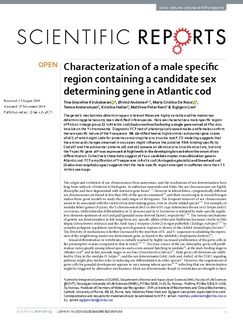| dc.contributor.author | Kirubakaran, Tina Graceline | |
| dc.contributor.author | Andersen, Øivind | |
| dc.contributor.author | De Rosa, Maria Cristina | |
| dc.contributor.author | Andersstuen, Terese | |
| dc.contributor.author | Vagonyte-Hallan, Kristina | |
| dc.contributor.author | Kent, Matthew Peter | |
| dc.contributor.author | Lien, Sigbjørn | |
| dc.date.accessioned | 2019-06-25T09:36:22Z | |
| dc.date.available | 2019-06-25T09:36:22Z | |
| dc.date.created | 2019-05-17T10:49:32Z | |
| dc.date.issued | 2019 | |
| dc.identifier.citation | Scientific Reports. 2019, 9 1-9. | nb_NO |
| dc.identifier.issn | 2045-2322 | |
| dc.identifier.uri | http://hdl.handle.net/11250/2602035 | |
| dc.description.abstract | The genetic mechanisms determining sex in teleost fishes are highly variable and the master sex determining gene has only been identified in few species. Here we characterize a male-specific region of 9 kb on linkage group 11 in Atlantic cod (Gadus morhua) harboring a single gene named zkY for zinc knuckle on the Y chromosome. Diagnostic PCR test of phenotypically sexed males and females confirm the sex-specific nature of the Y-sequence. We identified twelve highly similar autosomal gene copies of zkY, of which eight code for proteins containing the zinc knuckle motif. 3D modeling suggests that the amino acid changes observed in six copies might influence the putative RNA-binding specificity. Cod zkY and the autosomal proteins zk1 and zk2 possess an identical zinc knuckle structure, but only the Y-specific gene zkY was expressed at high levels in the developing larvae before the onset of sex differentiation. Collectively these data suggest zkY as a candidate master masculinization gene in Atlantic cod. PCR amplification of Y-sequences in Arctic cod (Arctogadus glacialis) and Greenland cod (Gadus macrocephalus ogac) suggests that the male-specific region emerged in codfishes more than 7.5 million years ago. | nb_NO |
| dc.language.iso | eng | nb_NO |
| dc.rights | Attribution-NonCommercial-NoDerivatives 4.0 Internasjonal | * |
| dc.rights.uri | http://creativecommons.org/licenses/by-nc-nd/4.0/deed.no | * |
| dc.title | Characterization of a male specific region containing a candidate sex determining gene in Atlantic cod | nb_NO |
| dc.type | Journal article | nb_NO |
| dc.type | Peer reviewed | nb_NO |
| dc.description.version | publishedVersion | nb_NO |
| dc.source.pagenumber | 1-9 | nb_NO |
| dc.source.volume | 9 | nb_NO |
| dc.source.journal | Scientific Reports | nb_NO |
| dc.identifier.doi | 10.1038/s41598-018-36748-8 | |
| dc.identifier.cristin | 1698468 | |
| cristin.unitcode | 192,10,1,0 | |
| cristin.unitname | Institutt for husdyr- og akvakulturvitenskap | |
| cristin.ispublished | true | |
| cristin.fulltext | original | |
| cristin.qualitycode | 1 | |

